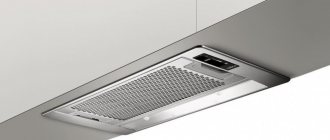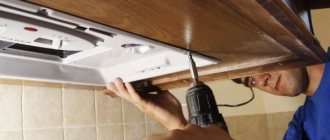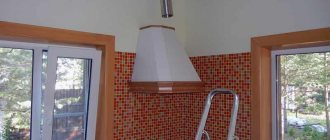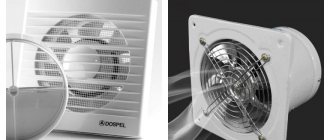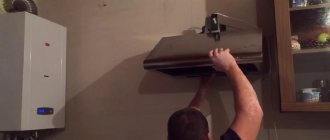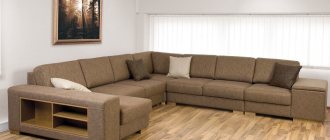Despite the availability of various semi-finished products, pizzas or hamburgers, and full meals delivered to your home, many Russian housewives still prefer to pamper themselves and their family with homemade dishes. And representatives of the stronger sex quite often come to the stove, not trusting store-bought food or wanting to surprise their family with a truly masculine culinary masterpiece. And for some, cooking and the art of cooking is a favorite hobby or profession.
Of course, during the cooking process on the stove, appetizing and not-so-appetizing odors appear. Hot fumes and greasy soot spread throughout the kitchen and throughout the house. To prevent negative consequences, experts give a clear answer: install the hood immediately, at the stage of installing the kitchen unit. But is this really necessary? Is it really impossible to do without a hood? Or can you rely on good natural, forced ventilation in the kitchen? Let us examine this issue in more detail, assessing the advantages and disadvantages of installing this unit.
Hood for domestic needs in the kitchen
This is a device designed to purify the air in the kitchen from gas combustion products, water vapor, small particles of soot and fat. That is, the whole bouquet that pollutes the air and the entire room during the heat treatment of products. It is purchased and installed separately from kitchen units, at the request of the homeowners. What are its features?
- The basis of the design consists of a body made of various materials - glass, plastic, metal. Dimensions, shape and colors depend on the installed design.
- The housing houses a motor that drives the fan. Its power varies, since devices are produced for both tiny and spacious rooms.
- Drawn in by the fan, polluted air passes through a system of carbon filters, or is discharged into the ventilation system and further into the street.
Thanks to these devices, the air in the kitchen is forcibly purified in a short time. If you turn them on at the very beginning of the cooking process, the vapors and soot simply do not have a chance to spread throughout the entire room.
Main function of the hood
Why do you need a hood, if everything seems to be fine? The hood does not create proper air exchange, and if it is disturbed, the hood will not save the situation.
But if the ventilation works as it should, I still recommend installing a hood: during the cooking process, tiny particles of hot fat and gas combustion products enter the air. And it is precisely from them that a good modern hood cleans the air.
Ventilation aggravates the situation if there is no hood in the kitchen: tiny drops of grease spread throughout the kitchen and settle on the furniture and even the ceiling. Anyone who washed a suspended ceiling once a year knows!
Diverter kitchen hoods
This class of exhaust devices is connected to the building’s ventilation system, or to pipelines leading through the wall to the street. Taking the air saturated with vapors from inside the room, they remove it outside through a filter on which soot remains. It is believed that such devices purify the air better and faster. But they also have disadvantages:
- not all houses have a ventilation system and it is not always possible to connect to it;
- pipes, even those chosen in color and shape, spoil the appearance of the kitchen and take up precious meters of space;
- installation is more difficult than for compact pendant systems.
To properly install and connect a tap-off model, experience or a hired specialist is required.
A little theory
Before we begin discussing the advantages and disadvantages of these household appliances, let us briefly examine their classification.
According to the principle of operation, hoods are divided into:
- recirculation - they draw in polluted air, clean it from burning, grease and soot through built-in filters and return it back to the room. They have average or low power, require regular replacement of filtration units, are noisy, do not cope well with unpleasant odors, but take up little space, are inexpensive and easy to install;
- flow-through ones - they quickly remove dirty air to the street through the ventilation system of the house along with an unwanted aroma, have impressive dimensions, require the involvement of specialists for proper installation, are expensive, but they cope with their tasks perfectly and almost do not bother the owners with extraneous sounds.
According to their design and installation method, they are:
- hanging - attached to the bottom of any cabinet;
- built-in - they act as part of a furniture set and visually do not give themselves away;
- dome - rise above the slab and go into the ceiling or wall;
- island - installed in the center of the kitchen and cover a large area.
There are hoods that combine flow and recirculation principles of operation and allow you to select the desired mode according to the circumstances.
Recirculating kitchen hoods
Circulation systems do not have air ducts. The dirty air supplied inside passes through a filter system, is cleaned, and then discharged back into the kitchen. That is, the same air circulates in the room, without access to fresh air from outside. Therefore, the kitchen must be ventilated from time to time, otherwise the concentration of carbon dioxide may exceed reasonable limits. In addition, such devices often cannot cope with rich odors and combustion products of household gas from a gas stove.
They also have advantages:
- compact dimensions;
- the ability to install under cabinets, in countertops, on walls;
- ease of installation.
This type of hood can be installed independently if you carefully follow the attached instructions.
What ventilation would be the best option?
For people who are building a large country house or making renovations in an elite apartment, we can recommend an expensive, high-quality and efficient ventilation system with heat recovery. Owners of expensive real estate install a powerful hood, and the outlet for the exhaust air should be made in the wall. Instead of a gas stove, it is better to use an electric household appliance due to lower emissions of carcinogens.
For developers who are limited in financial resources, the best option would be to use natural ventilation, which is supplied to the kitchen, bath and toilet, as well as auxiliary rooms. If a private house will use a hood installed above a kitchen stove, then a channel for removing waste air masses is made not in a vertical direction to the roof, but in the wall. A check valve is installed on the fan; it prevents cold air from entering the room from outside.
The best option for apartment owners is the natural ventilation already existing in the house. In addition, a hood is installed above the stove in the kitchen with air exhaust through a hole in the wall. If this option does not work, the fan is mounted in the riser of the existing duct, but the check valve is removed.
Dome kitchen hoods
The hoods of this model have an original canopy in the form of a dome, in which the engine, filters and all the necessary mechanics are located. Due to their interesting appearance, the devices are called “fireplace”. They are often used as an expressive decorative element. The only negative is the large dimensions.
Fiery motor...
The efficiency of any type of hood depends primarily on the motor. It determines how silently the entire system will operate, and how quickly and efficiently the hood will clean the air.
In high-quality modern hoods, the motor is placed on a noise-absorbing block, usually made of rubber, and an anti-vibration gasket separates the motor from the hood itself. All this allows you to make the operation of the entire air purification system in the kitchen almost silent.
A good hood during normal operation can purify up to 900 cubic meters of air per hour.
To calculate how many of these meters there are in your kitchen, multiply its area by the height of the ceilings. With a standard kitchen size, the extraction speed seems more than impressive.
When purchasing a hood, you should consider who exactly made the motor.
Ideally, it should be done by the company that produces the hoods themselves. The fact is that if after the purchase you have problems with your new purchase, you will go to the seller, the seller will send you to the manufacturer, and the manufacturer, possibly, to the motor manufacturer.
Hood or ventilation in the kitchen?
The debate over the need for hoods in the kitchen continues. People defend diametrically opposed opinions. Some people claim that it is impossible to live and create in the kitchen without it. But for some, this unit is a waste of money, since high-quality ventilation provides the necessary air exchange, and in extreme cases there are vents and transoms.
To understand whether the kitchen really cannot be done without an exhaust hood, it’s worth weighing the pros and cons. And, of course, the issue should be resolved taking into account specific facts. After all, the conditions in different apartments and houses are very different, and no two families have completely the same habits and way of life.
Arguments against kitchen hoods
According to many users, these devices are imposed by companies that manufacture household appliances and kitchen furniture. Opponents of installing hoods cite quite compelling reasons according to which the purchase of the investment does not justify and even brings certain inconveniences:
- during operation, the unit makes noise from the motor and fans, adding extraneous sounds to the otherwise restless atmosphere of the kitchen;
- if there is good, well-thought-out ventilation, there is not much difference between the presence and absence of an additional exhaust device. Today, many houses have a forced ventilation system, installing special mechanisms and motors with fans. If such communications are available, it makes no sense to spend money on a hood. But owners of apartments or private houses with poor or no ventilation should think about it. Its quality can be judged by the air and the presence of mold: if the atmosphere with the windows closed is fresh, with normal humidity, then everything is in order;
- many owners prefer to work in the kitchen with an open window or vent, which automatically makes the purchase of additional household appliances pointless;
- during operation, the device consumes electricity, which affects electricity bills;
- the owners practically do not cook in the kitchen, or prepare dietary dishes without frying the food;
- Fat and soot settle on the filter, creating a favorable environment for the development of microorganisms. Therefore, the hood needs proper care and timely cleaning and replacement of filter elements.
And, one of the main arguments against it is the lack of space in the kitchen. In small kitchens there is often no free space left in which to accommodate a dome or inclined hood with an air duct.
Arguments against"
- “All my life we managed without her and nothing happened.” Representatives of the older generation sincerely do not understand why install additional devices for air purification when it is enough to turn on a wall hood or arrange through ventilation through a window and door.
- "No extra money." Any equipment requires costs for purchase, installation and maintenance, and if the budget is sharply limited, they usually save on minor things, which include a range hood.
- “So little space.” Of course, a bulky island or dome model will not fit into the interior of a Khrushchev kitchenette, but a hanging or built-in option is not difficult to choose.
- "It's too loud." Yes, outdated appliances with weak motors are far from the standards of acoustic comfort, but among the new products you can find an inexpensive and quiet range hood.
- “It spoils the interior.” Equipment purchased for a ready-made kitchen can really deviate from the overall design concept. To avoid this, the purchase must be planned in advance, at the stage of repair and arrangement.
- “Filters are a breeding ground for infection.” This will happen if you do not replace them in a timely manner and do not clean the inside of the device.
- “I have an electric/induction stove.” Under this condition, the need for a kitchen hood is lower than when using gas, but cleaning the air from unnecessary moisture, odors and food particles will not hurt.
- “Household ventilation copes with ventilation.” A reasonable argument, but not everyone is so lucky.
- “I hardly cook at home.” Many busy people prefer to order food for delivery, purchase reheatable convenience foods, or eat out.
- "It's a fashion statement." Some people think that home appliance manufacturers exaggerate the benefits of hoods in order to promote their products on the market and capitalize on indoctrinated customers.
Pay attention to the noise level
Want to cook in relative silence? Choose a hood with a noise level of up to 45 decibels. True, quiet hoods are significantly more expensive, and sometimes their silence is achieved by reducing engine power.
- Which hood is better - with one super-powerful motor or with two slightly less powerful ones? The second option is preferable, as it allows the hood to work not too loudly and at the same time be quite effective.
- Inexpensive hoods are always noisy. Models with a noise level greater than 50 dB can be almost as loud and annoying as a hair dryer or vacuum cleaner.
How to install a hood with a ventilation outlet
You can install the hood yourself; this is not an easy, but completely doable task.
Required tools and materials:
- Corrugation or plastic box;
- Ventilation grille;
- Fastening or clamps (clamps, 2 pcs.) for corrugation;
- Drill;
- Screwdriver;
- Tape measure, pencil and level;
- Hacksaw for metal (for corrugation), knife.
Before you start work, you need to take measurements of where and at what height the hood will be located. It is necessary to correctly determine the distance from the stove to the hood and attach it securely.
Next you need to hang the hood to the wall and secure it securely. To do this, a frame of dowels and angles (U-shaped) is attached to the wall, this will be the support.
There is an option in which the hood is attached to kitchen cabinets.
Next, the corrugated pipe is attached using clamps to the ventilation system and to the hood itself. After which the hood is connected to the network.
At what height from the gas stove should the hood be installed?
Knowing which fasteners to install a kitchen hood on is not enough. It is important to correctly measure the distance for hanging equipment above the gas stove. There are special standards that must be followed if the kitchen is standard.
Also, the installation height of the hood can be changed if provided by the manufacturer.
Traditionally, the system is installed at a height of 65-90 cm above the hob. If you try to place the device a little lower, this may affect performance, because high temperatures may cause some parts to become deformed.
It is advisable to install a hood higher only when a tall person in the family prepares food, and the device has sufficient power and is capable of extracting smoked air even from the bottom of the room.
We specify the dimensions of the stove and hood
The main principle for choosing a hood by size is simple: the width of the hood should correspond to the width of the stove or be larger than it (but not smaller!).
- For this reason, the most popular appliances are hoods with a width of 50 cm, 60 cm and 90 cm.
For very large slabs, you can choose a hood with a width of 120 cm or 100 cm, although their choice is not very large.
- The depth can be from 30 to 50 cm. Although this parameter is not so important, it is still better to choose the device so that its visor does not protrude too much above the stove, otherwise you can hit it.
If you choose a fireplace hood, the height of the device also matters. After all, it talks about the maximum allowable distance between the bottom surface of the umbrella and the ventilation hole it allows. Some hoods are 1.5 m high, while others are only 1 meter.
- By the way, important information: the hood must be installed at least 60 centimeters from the stove.
Read more in the material: What size should a kitchen hood be?
Filters for hoods operating in recirculation mode
Hoods operating in air purification and recirculation mode are sometimes called coal hoods. This is not entirely correct, since their design, as we have seen, essentially does not change.
But cleaning the air pumped through the device is impossible without a carbon filter.
The filter is a plastic or metal cassette of rectangular or round shape, the internal space of which is filled with activated carbon.
Some models additionally use synthetic material impregnated with the same coal.
Carbon filters work effectively for three to four months with active use of the hood. But the manufacturer indicates the exact operating time in the instructions included with the product.
Some modern models of hoods are equipped with a self-diagnosis system, which shows how much the carbon filter's resource has been spent. That is, it is easier for the owners of the device to keep the situation under control.
Another mandatory filter that a hood cannot do without, regardless of its operating principle.
We are talking about a grease trap. If you do not install it, then after a very short time all the insides of the hood, including the fan blades, valve flaps, and duct walls will become overgrown with a thick fatty deposit, which will be extremely difficult, if not impossible, to remove.
The grease filter is located directly at the entrance to the device.
It can be a thin metal (aluminum) mesh, in the cells of which fatty fumes are retained. Another option is fabric or paper liners, which are also effective at trapping fat.
Thus, grease particles from the steam rising from the stove remain on this filter, and unpleasant odors and other contaminants are finally “cleaned out” in the coal filter.
The mesh metal grease filter must be cleaned approximately once a month.
As a rule, these hood parts can be washed well in the dishwasher or by hand, with preliminary soaking in hot water with the addition of a detergent that does not contain abrasive ingredients.
From time to time, such filters are replaced with new ones, which can be purchased in one of the specialized stores or on the Internet.
By the way, they can be original, that is, produced by the hood manufacturer, or universal, which are suitable for various models. The cost of the latter is somewhat lower than the original products, but the quality, it must be said, is “thinner”.
In paper or fabric grease filters, the inserts are replaced with new ones.
The problem with filters, by the way, is one of the most serious. Many homeowners who once previously made their choice in favor of a kitchen hood operating on the principle of recirculation have already regretted it.
The efficiency is still not the same as with complete removal of vapors, and the frequent need to replace filters, which sometimes may not be found in the store, begins to irritate.
And therefore, there are quite common pictures when the owners gave up on this matter, stopped changing carbon filters, and are content with natural ventilation. And the hood itself is not removed above the stove only because they are already accustomed to its presence and the fact that it provides illumination.
So you need to think in advance...
Ventilation system design
A project for private housing construction or an apartment building without organizing a natural ventilation system will not be accepted by the relevant organizations.
To remove accumulated moisture, heat flow, and unpleasant odors, ventilation exhaust ducts are planned.
The flow of fresh air is carried out naturally, or through organized channels near the window.

